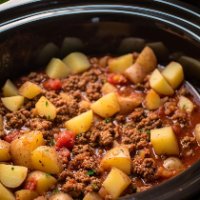






S erves: 5 The recipe lends itself to cooking for a crowd. See below.*
erves: 5 The recipe lends itself to cooking for a crowd. See below.*
Ingredients:
1 lb. ground beef, browned and drained (Ground turkey or chicken, stew meat or lamb can be used instead.)
1.5 lbs potatoes, peeled and diced large. Thin-skinned new potatoes may be scrubbed and used unpeeled
3 carrots, peeled and sliced
1 onion, diced
1 garlic clove, minced
1 (6-oz.) can tomato paste
2 C water
1 tsp salt
1/4 tsp pepper
1 tsp onion powder
1 tsp dried oregano
1 can each peas and cut green beans or equivalent frozen vegetables of your choosing. (optional)
Instructions:
Add the cooked ground beef, potatoes, carrots, onions, and garlic to a 5-quart or larger slow cooker.
In a small bowl whisk together the tomato paste, water, salt, pepper, onion powder and oregano. Pour this mixture over everything in the slow cooker. Stir.
Cover and cook on low for 6-7 hours, without opening the lid during the cooking time.
Halfway through cooking time, add drained canned or frozen vegetables, if using.
Serve with bread and butter.
Notes: If desired, you can thicken the stew by mixing 2 tablespoons of cornstarch with a small amount of water to create a slurry. Stir the slurry into the stew during the final 30 minutes of cooking.
For oven roasting, a Dutch oven or roasting pan can be used instead of a slow cooker. Bake in a 325-degree oven for 2 hours.
*To prepare for a crowd, multiply your ingredients and oven roast. Or use a large electric “Nesco”-type roaster.
Parboil potatoes and carrots as you prepare the other ingredients.
Add cooked meat, onions, parboiled and drained potatoes and carrots, onions and garlic to 2 large electric roasters or 2 large covered oven roasting pans.
Adjust oven racks and preheat the oven, if using, to 325 degrees. Whisk together the tomato paste, water, salt, pepper, onion powder and oregano. Pour this mixture over the stew ingredients. Stir well.
Cover and cook on low in electric roaster for 6-7 hours OR in a 325-degree oven in large oven roasters for 3-4 hours. Stir twice during the cooking time. About 2 hours into cooking time, add drained canned vegetables. When potatoes are tender and gravy is flavorful, remove all bay leaves carefully and serve.
“If there were a dish I could eat over and over again this would be it,” says Jessica Jacobs on the Cooktop Cove site that offers this recipe and the photo above.
Story:
In Christine Valters Paintner’s Lenten reflection book, there is an invitation to fast from “speed and rushing in order to embrace slowness and pausing.” This is easy for some, but our world, our minds and our hands often seem to move at a fast pace. We all could use a pause in aspects of our lives whether at work, school, on a committee or in the kitchen. Pausing for rest, reflection and time to center ourselves can fill us with the grace to be our best selves and to be a healing presence for others.
For example, slowness can be meditative in the kitchen. Making, smellig and eating a simple pot of stew creates a slow winter pause to savor a hearty, uncomplicated meal with simple, inexpensive ingredients. Our family served it with crusty bread to soak up the flavorful gravy. In honor of Saint Patrick, make it with lamb instead of ground beef/stew meat, or try a vegetarian version with navy or pinto beans. A bright and accomplished person I know bakes his own bread. A recovering workaholic, he decided, “If I’m too busy to bake bread, I’m too busy”, and he bakes a couple of times a month.
In the kitchen, if not making bread or a tasty soup or stew, try slow roasting a chicken or meditatively chop veggies for several meals and put them in the fridge for the week’s cooking. Make great pasta sauce or another favorite fragrant recipe that cooks for hours. Even if you use a slow cooker, slow food can be one antidote to rushing through life.
FYI: Slow Food is actually a movement founded by Carlo Petrini and others as a reaction to a fast food restaurant being built near the Spanish Steps in the middle of Rome. They soon wrote the Slow Food Manifesto which states that “Slow Food assures us of a better-quality lifestyle. With a snail purposely chosen as its patron and symbol, it is an idea and a way of life that needs much sure but steady support.”
Since then, Slow Food has grown into a global movement of eaters, cooks, food producers, and activists working together to ensure good, clean and fair food for all. Its current president is Edward Mukiibi, an agronomist from Uganda. Slow Food prioritizes:
Food Biodiversity by promoting agro-ecological practices and sustainable consumption choices.
Education by promoting understanding of where food comes from—how it was produced and by whom—so we can learn to combine our pleasure with a sense of responsibility to preserve food’s cultural and social value for people all over the world.
Advocacy for justice for those who grow our food, for eaters, and for the planet. Advocacy needs to address government and corporate actions that have polluted many food systems, compromising the health of humans, other-than-human species and the planet, in pursuit of profit.
Check out Slow Food!





Post a Comment